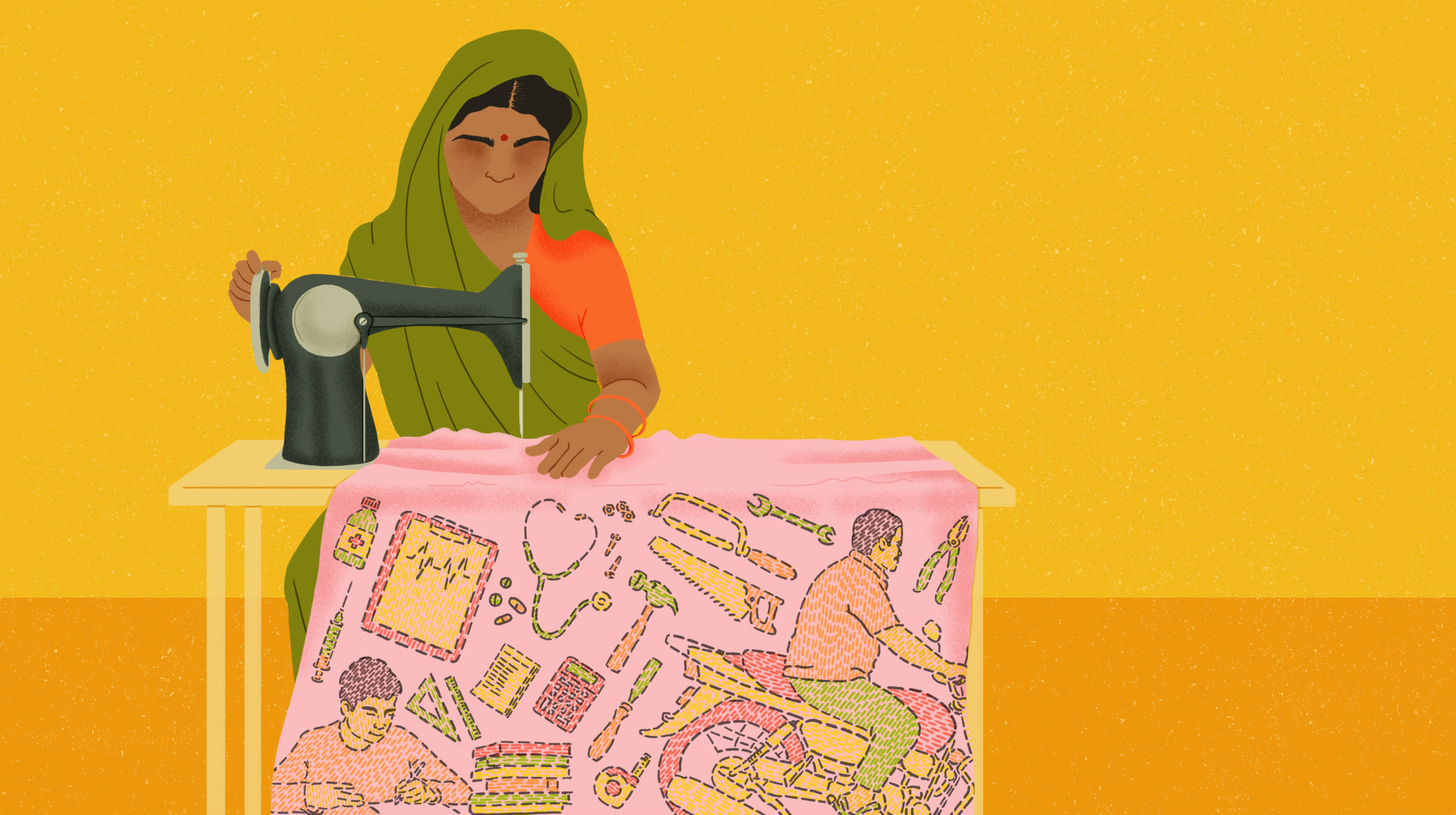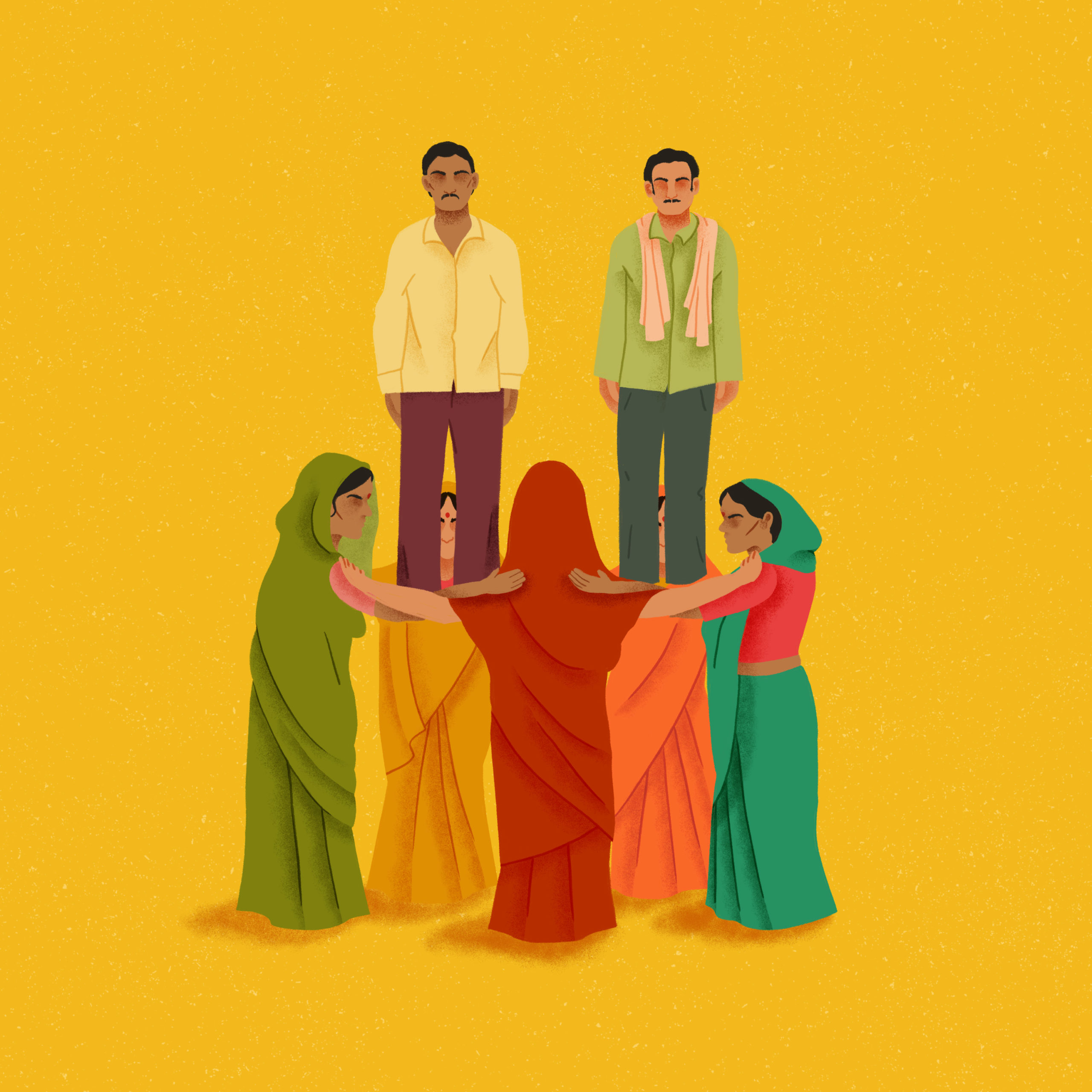In early March, 30-year-old Pinky Devi took out her latest small loan in the densely populated state of Bihar in northern India, where she lives with her husband and two sons.
Like the other sums of rural credit Devi has borrowed over the last 12 years, the $1,340 did not go to her work as a seamstress but instead to her breadwinner husband.
Thirty-two-year-old carpenter Sunil Kumar Sharma needed to buy a motorcycle for his latest furniture business so he could zip around their village to take orders. Taking out the loan fell to his wife: In India, as it is around the world, most microfinancing is available primarily to women.
As long as Sharma was working, they reasoned, paying back the steep weekly payment of $40 would not be a problem. After all, the couple had used microfinancing to plug the gap in their finances for over a decade, and they had always managed to repay on time.
But a few weeks later, COVID-19 swept through India’s heartland, forcing the whole country into lockdown. Devi’s sewing orders instantly dried up and Sharma, like many in India, was taken by surprise by the government’s last-minute decision to shut down. With only a few hours’ notice, he didn’t have time to collect his tools and materials to work from home. Getting to his workshop in town was impossible: it sits opposite the local police station, where officers strictly enforced the lockdown.
“All of a sudden his work stopped,” Devi says over a video call in her bright pink home, where bare cement still covers most of the floors. “We worried what would happen if it continued, how would we repay our debts or even meet our expenses?”
The gap widens between men and women’s access to opportunity
Millions of income-insecure women in parts of rural India take on microfinance loans to fulfill the household needs — groceries, house repairs, seed money for their husbands’ businesses — to counter economic downturn. Now, with less cashflow and more debt piling up during the pandemic, they are deferring loans with high rates that threaten their already fragile economic security and widening the gap between men and women’s access to opportunity.
Set up in the 1980s, microfinancing was heralded as a champion of women’s empowerment, extending cash to women who had never used or even visited a bank before.
Devi took out a loan as part of a group of villagers. Dubbed the peer pressure model by the industry, lenders reach out to women in remote areas, and rely on the power of a dozen or more women to force each other to repay their loans on time.
The women, who are allowed to take up to three loans of $2,000, meet each week to collect weekly installments for the loan officer. It’s in everyone’s interest to ensure each member pays back their loans on time: if one defaults, the whole group could be denied future access to credit. But such social collateral can also become the system’s Achilles heel.
Loan officers, say social workers on the ground, can become aggressive, showing up at a woman’s doorstep without warning. Fights have broken out between lenders and families, and there has been violence within the groups, or even between the woman borrower and her husband. There have been instances of domestic violence following a loan officer’s knock on a door.
Apart from facing the ire of the group, many women take to labouring for little wages, selling their jewellery or taking out exploitative informal loans.
“There is a problematic reinforcement of patriarchy, even while arguing for women’s empowerment,” said Sohini Kar, who is an Associate Professor of International Development at London School of Economics, and has studied the socio-cultural dimensions of the microcredit sector.
Filling in the gaps of household expenses

Like many women across India, Devi’s loans have benefited her, but indirectly.
On video, she proudly shows off her sewing machine, sitting besides an unpainted staircase that leads to an unfinished upper floor. Over the last decade, the house has been built in stages. Logs of wood, a half-finished bedframe and a headboard are neatly piled in different corners of the house.
“Whenever we had money to spare, we would finish a different part of the house,” she says, her small golden earring and nose stud glistening in the early afternoon light.
It was Devi’s borrowed credit that filled the gaps in household expenses. Her loans have financed repairs on the house, her husband’s furniture business, healthcare bills, and education for their two adolescent sons, both of whom she had when she was a teenager herself.
“Over 80 percent of the women borrowers are a front for the households and male members of the family to access these loans,” said Dr Supriya Garikipati, a development economist at the University of Liverpool whose work has found that women rarely use the loans to secure a livelihood.
On paper, Devi could be borrowing for an entrepreneurial venture of her own design, but neither the banks nor India’s financial regulators care what her loan is used for. As long as the repayments are timely, her access to credit continues.
Her two sons study online through a smartphone since the family won’t be able to afford a computer this year. The rooftop terrace remains unfinished.
Though her debt has funded the house and her husband’s business, Devi is happy she lives in a better house than a decade ago. But she has hardly any assets to her own name.
Devi was relieved when India announced a moratorium on repaying the loans four days after the late March lockdown came into effect. But nearly six months later, when the moratorium was lifted, her loan officer demanded she repay the credit with the accumulated interest right away. The couple was flummoxed.
“We were quite tense,” she says. The debt was too much to handle. “We paid back the initial installments from our savings.”
India has the largest microcredit clientele in the world — with more than 85% of its clients women — according to PricewaterhouseCoopers, and the industry is routinely called out for questionable lending policies. The most problematic came around 10 years ago when the suicide of 57 indebted farmers was linked to MFI practices. The industry emerged from the crisis with several reforms to regulate and control MFIs with strict rules on over lending, multiple lending, and caps on borrowing. But not all the changes have been implemented.
Stuck in a vicious cycle
Devi was worried the women in her group would chide her for not having enough money to repay the loan. But in September, at her first in-person meeting after lockdown, she discovered that no one in the group would be in a position to pay.
Interactions with the loan officer in recent weeks have become increasingly tense. He started showing up at the women’s weekly meetings, Devi said, demanding the loan be immediately repaid in a lump sum.
The Microfinance Institutions Network, the Indian association for the industry, said it believed borrowers across the country were “highly resilient”, its chief executive officer Alok Misra said in e-mailed answers. “In most cases, we are seeing a bounce back to normalcy as livelihoods are increasingly restored.”
But Devi’s group is not the only ones who can’t pay. Before the pandemic, repayment rates in the microcredit sector were over 90% — a healthy amount that allowed the system to thrive. But this fell to 70% in August and 80% in September, according to industry lobby Sa-dhan. Experience from previous crises shows that a slip in repayments from 95% to below 85% would render MFIs insolvent in a year, according to Greta Bull, CEO of Consultative Group to Assist the Poor (CGAP), a global think-tank on financial inclusion.
Post-lockdown, the confusion over repayments has worsened due to unclear policies, said Sajay Sinha, Executive Director of the microfinance analytics firm M-Cril. The government and Reserve Bank of India (RBI) were unclear about the moratorium’s terms, he explained.
“Too much was left to the discretion of individual institutions, lenders, the big banks financing the sector and others,” Sinha said. Expecting poor borrowers mostly from India’s informal sector to repay the moratorium dues in full is problematic, he added.
The RBI did not respond to repeated requests for comment.
Some other countries came up with different solutions. In Pakistan, moratoria of a year was granted to borrowers for their principal payments. Kenya rescheduled personal loans without passing on any fees to the borrowers.
In India, the smaller lenders may collapse, Sinha says, and borrowers may face a crunch in credit access leading to the resurrection of informal money lending.
The credit crunch is already underway: In the April-June quarter of 2020, the number of loans and the amount disbursed by Indian MFIs dropped by 97% as compared to the same period last year.
Without an income, Devi’s finances are stretched thin and if the couple experiences another setback — such as a second lockdown or family illness — they face becoming impoverished.
Despite her current debts, Devi has no other option but to rely on rural credit.
But she is stuck in a vicious cycle: she isn’t able to repay, meaning she can’t borrow again. If microcredit isn’t available she will have to borrow from the exploitative and unregulated loan sharks.
Successfully avoiding them has been a source of pride, but that could now be in jeopardy. Her husband has only now managed to start up work again.
“How will we mobilize those kinds of funds?” she wonders.


 Mahima Jain
Mahima Jain
